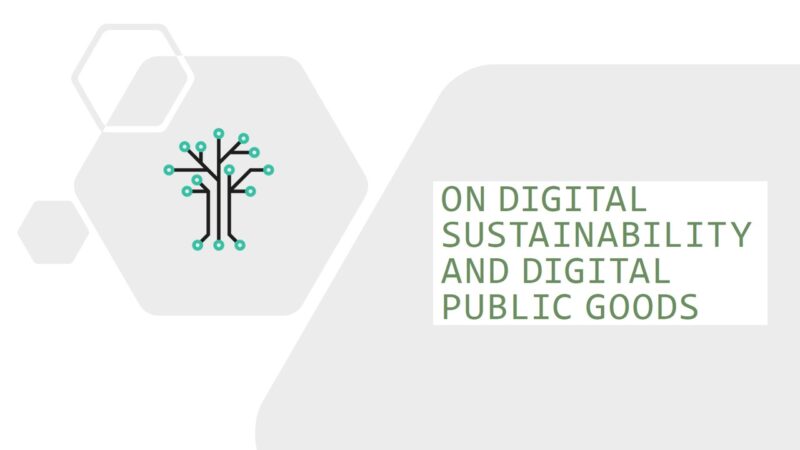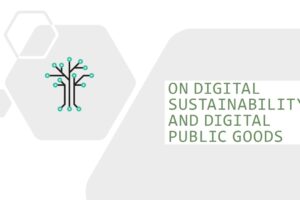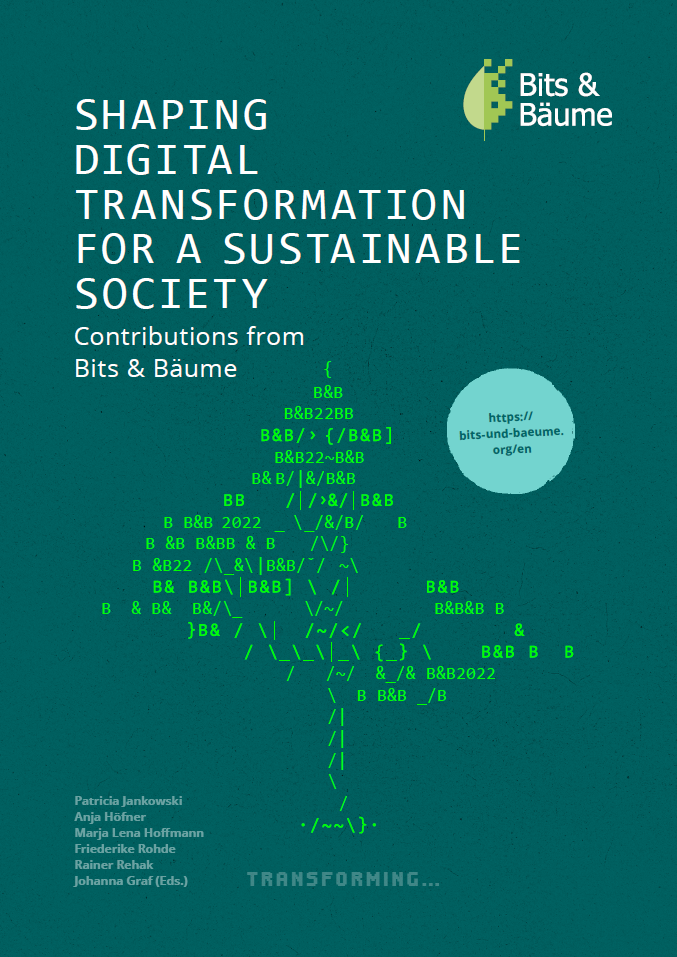Bits & Bäume Beitrag : Digitale Nachhaltigkeit und Digitale öffentliche Güter


Themen: Digitale Nachhaltigkeit, Forschung, Klimaschutz
Im September 2022 fand in Berlin die zweite „Bits & Bäume“ Konferenz statt. Die Konferenz brachte die Gemeinschaften der Digitalisierung und der Nachhaltigkeit zusammen und bot Raum für einen Ideenaustausch mit dem gemeinsamen Ziel, die Digitalisierung zur Förderung der Nachhaltigkeit zu gestalten. Als Resultat entstand ein Begleitbuch, das die Erkenntnisse, Arbeiten, Forschungen und Meinungen von mehr als 65 Autoren mit einem „Bits & Bäume“-Hintergrund zusammenfasst.
In einem Beitrag über „Digitale Nachhaltigkeit und digitale öffentliche Güter“ schrieb Matthias Stürmer zusammen mit Markus Tiede (CHOpen), Jasmin Nussbaumer (Berner Fachhochschule IPST) und Flurina Wäspi (Berner Fachhochschule IPST) über die Digitalisierung und digitales Wissen als schützenswerte Ressourcen für einen nachhaltigen Wandel. Die Autoren plädieren für eine „twin transition“, d. h. die gleichzeitige Bewältigung des digitalen und des grünen Wandels, so dass sie sich gegenseitig verstärken.
Als erstes müssen die negative Effekte der Produktion und Nutzung von digitalen Technologien minimisiert werden. Zweitens muss der positive Einfluss von digitaler Technologie maximiert und genutzt werden, um die Zielsetzung der Agenda 2023 der Vereinten Nationen zu erreichen.
Obwohl im ersten Moment die intellektuellen Eigentumsrechte für das Erreichen der beiden Zielsetzungen als weniger wichtig angesehen werden, argumentieren die Autoren, dass langfristig intellektueller Eigentum ausschlaggebend für die (Weiter-)Entwicklung von nachhaltigen Technologien sei.
Es ist essentiell, Zugriff auf den ursprünglichen Source Code eines Algorithmus zu haben, ohne die relevante Software-Lizenz kaufen zu müssen.
Nach Angaben der Vereinten Nationen gehören zu den digitalen öffentlichen Gütern offen lizenzierte digitale Artefakte wie Open-Source-Software, offene Daten, offene Modelle künstlicher Intelligenz (KI), offene Standards und offene Inhalte. Dementsprechend sind die digitalen öffentlichen Güter, auch Digital Public Goods (DPG) genannt, essentiell für das Ausschöpfen des vollen Potentials der digitalen Daten und Technologien, um die Sustainable Development Goals (SDGs) der Vereinten Nationen zu erreichen.
Das Konzept der „digitalen öffentlichen Güter“ stützt sich auf das wirtschaftliche Verständnis von öffentlichen Gütern, die nicht ausschliessend und nicht rivalisierend sind.

ON DIGITAL SUSTAINABILITY AND DIGITAL PUBLIC GOODS
Several 2022 reports from government and academic organisations contain the key message that sustainable development can be achieved using digital technologies. The report ‹Digital Reset› (Digitalization for Sustainability, 2022) calls for using digital technologies to reduce greenhouse gas emissions and resource waste in the agriculture, mobility, industry, and energy sectors. The researchers see digitalisation as a means to an end for sustainable transformation. Similarly, the report by the Coalition for Digital Environmental Sustainability (CODES, 2022), presents an action plan that includes impact initiatives to «achieve a sustainable planet in the digital age». The EU argues that digital technologies must play a key role in achieving climate neutrality in the EU by 2050 (Muench et al., 2022). The authors call for a ‹twin transition›, managing digital and green transitions simultaneously so that they reinforce each other.
ALIGNING DIGITALISATION WITH ENVIRONMENTAL AND SOCIAL SUSTAINABILITY
Aiming for ‹sustainable digitalisation› and aligning digitalisation more closely with environmental and social sustainability means two things. First, the negative effects of producing and using digital technology have to be minimised by improving hardware production, reducing energy consumption, decreasing electronic waste, and avoiding the need for frequent replacement of devices altogether. Second, the positive impact of digital technology must be maximised by using it to achieve the goals and targets of the United Nations Agenda 2030.
In the short term, these two objectives can be accomplished by any type of technology, independent of intellectual property rights. It does not matter whether a company provides a proprietary software product or the software’s source code is available under an open source license. It is the resulting software tool or the benefits of a data analysis that matter, not the accessibility of the algorithms or the openness of the raw data. However, decision-makers and sustainability experts, and even digitalisation experts, sometimes erroneously forget that, in the long run, it is essential to have access to the original source code of an algorithm and to reuse a programme without the need to purchase the relevant software license. Contrary to some beliefs, in the long term, intellectual property is crucial. Imagine a company developing a system that helps a city optimise traffic to reduce greenhouse gas emissions. The city that buys the services benefits from improved mobility management and reduced air pollution. However, other governments might either not be able to afford the licensing costs or do not want to be dependent on technology companies. Resultingly, due to intellectual property laws, the positive effect of this proprietary digital technology on green transition is limited and important public sector institutions are hindered in benefitting from digital transformation.
THE VALUE OF DIGITAL PUBLIC GOODS
The UN recognised the value of openly available digital artefacts for sustainable development in the 2020 UN Roadmap for Digital Cooperation (UN Secretary General, 2020). The report points out that ‹digital public goods› are essential in unlocking the full potential of digital technologies and data for reaching the Sustainable Development Goals (SDGs). The concept of ‹digital public goods› builds on the economic understanding of public goods that are non-excludable (everybody has access to them) and non-rivalrous (using such goods does not decrease the value for others). According to the UN, digital public goods
include open-licensed digital artefacts such as open source software, open data, open artificial intelligence (AI) models, open standards, and open content. Additionally, digital public goods must also adhere to further requirements (Pomerantz and Peek, 2016). The Digital Public Goods Alliance (Digital Public
Goods Alliance n.d.) has defined nine indicators that determine whether a software programme, a data repository, an AI model, or a data standard can be considered a digital public good. According to the alliance’s ‹Digital Public Goods Standard› (DPGS, Digital Public Goods Alliance, n.d.), a digital public good (1) advances the SDGs, (2) uses an approved open license, (3) has clear ownership, (4) is independent of proprietary components, (5) involves good documentation, (6) allows extraction of data,(7) adheres to privacy laws, (8) is aligned with technical standards and best practices, and (9) does no harm by design. With this definition, digital public goods have potential for sustainable development within the public sector. Using digital public goods, governments are able to build their own digital public infrastructure such as electronic identification (E-ID) or data exchange platforms, increasing their digital sovereignty and lowering vendor lock-in (Nordhaug and Harris, 2021). Within the boundaries of the DPGS criteria, no restrictions exist on how public institutions or the private sector may use and advance those goods. The DPGS criteria enable government actors, researchers, entrepreneurs, journalists, and citizens
to access the technical architecture and reuse existing digital public goods for sustainable transformation. For example, the District Health Information System (DHIS2) is an open source software used in many developing countries to increase efficiency and transparency in the health and education sector. The software supports several SDGs and is portrayed in the Digital Public Goods Registry as it fulfils all the requirements listed above. The researchers developing this platform at the University of Oslo have elaborated in detail how this digital technology relates closely to the concept of a digital public good (Nicholson et al., 2022). An overview of how DHIS2 complies with the nine requirements of the DGPS is provided on the website (Digital Public Goods Alliance, n.d.). For example, thorough documentation (Indicator 5) is provided on GitHub in various languages and for various target audiences, including
medical staff and software developers.
DIGITAL PUBLIC GOODS AND DIGITAL SUSTAINABILITY
New concepts and calls for action in the context of digital public goods are emerging. For example, the Digital Impact Alliance (2022) launched the Digital Public Goods Charter. It provides recommendations on how organisations should start and maintain digital public goods on financial, operational, and communicational levels. Interestingly, it picks up aspects of digital public goods that have already been developed in the context of digital sustainability and sustainability research (Stuermer et al., 2017): Funding long-term maintenance effort, disseminating knowledge, building a diverse ecosystem, and implementing a governance framework to mitigate risks and maximise benefits. The concept of ‹digital sustainability› (Stuermer et al., 2017) encompasses three levels of interaction: the digital artefact, the surrounding ecosystem, and the implications for society and the planet. There are four conditions that must be met for a digital artefact to be named as ‹digitally sustainable›: (1) elaborateness (quality of the software or data), (2) transparent structures, (3) semantic data (data is machine-readable including metadata), and (4) distributed location. In addition, the individuals and organisations producing and using the digital artefacts have to fulfil five additional conditions: (5) open licensing regime, (6) shared tacit knowledge, (7) participatory culture, (8) good governance, and (9) diversified funding. Finally, the combination of the digital artefact and its ecosystem has to (10) contribute to sustainable development.
That understanding of digital sustainability fits well with the concept of ‹digital public goods›: Both advance the SDGs, both require open licenses, and both expect high quality and best practices. In addition, the DPGS adds ownership, independence of proprietary components, good documentation, possibility of data extraction, compliance with privacy laws, and no harm by design; digital sustainability adds characteristics of a healthy community such as a broad organisation- independent distribution of skills and experience, facilitation of participation, and good governance mechanisms.
TOWARDS A COMPREHENSIVE UNDERSTANDING OF DIGITAL SUSTAINABILITY
Research focusing on a consolidated model of ‹digital sustainability› and ‹digital public goods›establishes a coherent framework with the characteristics of both concepts. This framework fulfils the definition of open technologies serving the planet and emphasises the benefits of freely available digital artefacts for our society. The framework also helps to transfer activities from one type of digital artefact to another. For example, the ‹Public Money Public Code› campaign by the Free Software Foundation Europe (n.d.) has inspired many advocates of Free Software to promote the campaign in politics. Similarly, Wikimedia Germany is pursuing a campaign to open up the educational content of public broadcasting (Wikimedia, 2022). These activities support policy-making processes (e.g., in the Swiss parliament) and provide a line of thought for political discussion. By joining the features of digital sustainability and
digital public goods, governmental adoption of those features can be accelerated, increasing the benefits of digitalisation for society and the planet.
Herausgeber des Begleitbuches:
Jankowski, P., Höfner, A., Hoffmann, M. L., Rohde, F., Rehak, R. & Graf, J. (Eds.) (2023). Shaping Digital Transformation for a Sustainable Society. Contributions from Bits & Bäume. Technische Universität Berlin. https://doi.org/10.14279/depositonce-17526
Kommentar erfassen